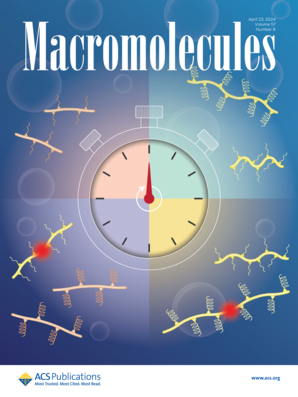含单分散椭球形聚离子液体颗粒悬浮液的界面极化和电流变特性
IF 5.1
1区 化学
Q1 POLYMER SCIENCE
引用次数: 0
摘要
分散相颗粒的形状参数,如长径比,对复合材料和悬浮材料的性能有显著影响。然而,由于难以制备具有相同单个颗粒体积和化学结构但不同长径比的均匀介电颗粒,因此长径比对颗粒悬浮液电流变效应的影响仍然存在争议。本文采用热拉伸法制备了具有不同长径比的均匀椭球形聚离子液体(PIL)颗粒,并研究了长径比对椭球形聚离子液体悬浮液ER效应的影响。由于椭球型PIL颗粒是由相同的均匀PIL微球单轴拉伸得到的,因此它们是具有相同的单个颗粒体积、密度和化学结构,尺寸分布和形状均匀的长条旋转椭球(球)。特别是,PIL颗粒不亲水,因为它们有多原子含氟反离子。因此,我们排除了体积、密度、化学结构、颗粒大小和形状分布以及外界水分对内质网效应的影响,使宽高比成为影响内质网效应的唯一因素。在电场作用下,我们发现随着长径比的增大,PIL颗粒悬浮液的内电效应先减小后增大。电介质谱分析和微观ER结构观察表明,低纵横比椭球型PIL粒子沿长轴和短轴两个界面极化的介电强度和弛豫时间差异不显著,导致低纵横比椭球型PIL粒子沿电场方向随机定向,形成短而薄的链状ER结构。这就是为什么它们的内电效应比球状粒子低的原因。然而,高纵横比椭球型PIL粒子在长轴上的极化强度显著增加,导致它们在低颗粒体积分数下沿电场方向与长轴定向,形成厚的网状内质网结构,这就是其内质网效应显著增强的原因。此外,我们发现,中等体积分数的低纵横比椭球型PIL颗粒悬浮液的沉降速度比球形颗粒悬浮液更快,而高纵横比颗粒悬浮液的沉降速度明显降低。本文的研究结果清楚地阐明了展弦比对颗粒悬浮液ER效应的影响。本文章由计算机程序翻译,如有差异,请以英文原文为准。

Interfacial Polarization and Electrorheology of Suspensions Containing Monodispersed Ellipsoidal Poly(ionic liquid) Particles
The shape parameters of dispersed phase particles, such as the aspect ratio, have a significant influence on the performance of composite and suspension materials. However, due to the difficulty in preparing uniform dielectric particles having the same individual particle volume and chemical structure but different aspect ratios, the influence of the aspect ratio on the electrorheological (ER) effect of particle suspensions remains controversial. In this article, we prepared uniform ellipsoidal poly(ionic liquid) (PIL) particles with different aspect ratios via a thermal stretching method and investigated the influence of aspect ratio on the ER effect of suspensions containing ellipsoidal PIL particles. Because the ellipsoidal PIL particles are obtained by uniaxially stretching the identical uniform PIL microspheres, they are prolate ellipsoids of revolution (spheroids) having the same individual particle volume, density, and chemical structure and uniform size distribution and shape. In particular, the PIL particles are not hydrophilic because they have polyatomic fluorine-containing counterions. Thus, we remove the influences of volume, density, chemical structure, size and shape distribution of particles, and external water on the ER effect, leaving the aspect ratio as the sole factor to affect the ER effect. Under electric fields, we found that, unlike the early conclusion, the ER effect of PIL particle suspensions first decreases and then increases with the increase in aspect ratio. Dielectric spectroscopy analysis and microscopic ER structure observation showed that the difference in the dielectric intensity and the relaxation time of the two interfacial polarizations along the long axis and short axis of low-aspect-ratio ellipsoidal PIL particles is not significant, which leads low-aspect-ratio ellipsoidal particles to orientate randomly along the direction of the electric field and form short and thin chain-like ER structures, and this is the reason why their ER effect is lower compared to their spherical counterparts. However, high-aspect-ratio ellipsoidal PIL particles exhibit significantly increased polarization intensity along the long axis, which leads them to orient with their long axis along the direction of the electric field and form a thick, network-like ER structure at even low particle volume fraction, and this is why their ER effect significantly increases. Additionally, we found that the settling velocity of the low-aspect-ratio ellipsoidal PIL particle suspension with a moderate volume fraction is even faster than that of the spherical counterpart, while that of high-aspect-ratio particle suspensions is significantly reduced. The results of this paper give clear clarification about the influence of aspect ratio on the ER effect of particle suspensions.
求助全文
通过发布文献求助,成功后即可免费获取论文全文。
去求助
来源期刊

Macromolecules
工程技术-高分子科学
CiteScore
9.30
自引率
16.40%
发文量
942
审稿时长
2 months
期刊介绍:
Macromolecules publishes original, fundamental, and impactful research on all aspects of polymer science. Topics of interest include synthesis (e.g., controlled polymerizations, polymerization catalysis, post polymerization modification, new monomer structures and polymer architectures, and polymerization mechanisms/kinetics analysis); phase behavior, thermodynamics, dynamic, and ordering/disordering phenomena (e.g., self-assembly, gelation, crystallization, solution/melt/solid-state characteristics); structure and properties (e.g., mechanical and rheological properties, surface/interfacial characteristics, electronic and transport properties); new state of the art characterization (e.g., spectroscopy, scattering, microscopy, rheology), simulation (e.g., Monte Carlo, molecular dynamics, multi-scale/coarse-grained modeling), and theoretical methods. Renewable/sustainable polymers, polymer networks, responsive polymers, electro-, magneto- and opto-active macromolecules, inorganic polymers, charge-transporting polymers (ion-containing, semiconducting, and conducting), nanostructured polymers, and polymer composites are also of interest. Typical papers published in Macromolecules showcase important and innovative concepts, experimental methods/observations, and theoretical/computational approaches that demonstrate a fundamental advance in the understanding of polymers.
 求助内容:
求助内容: 应助结果提醒方式:
应助结果提醒方式:


